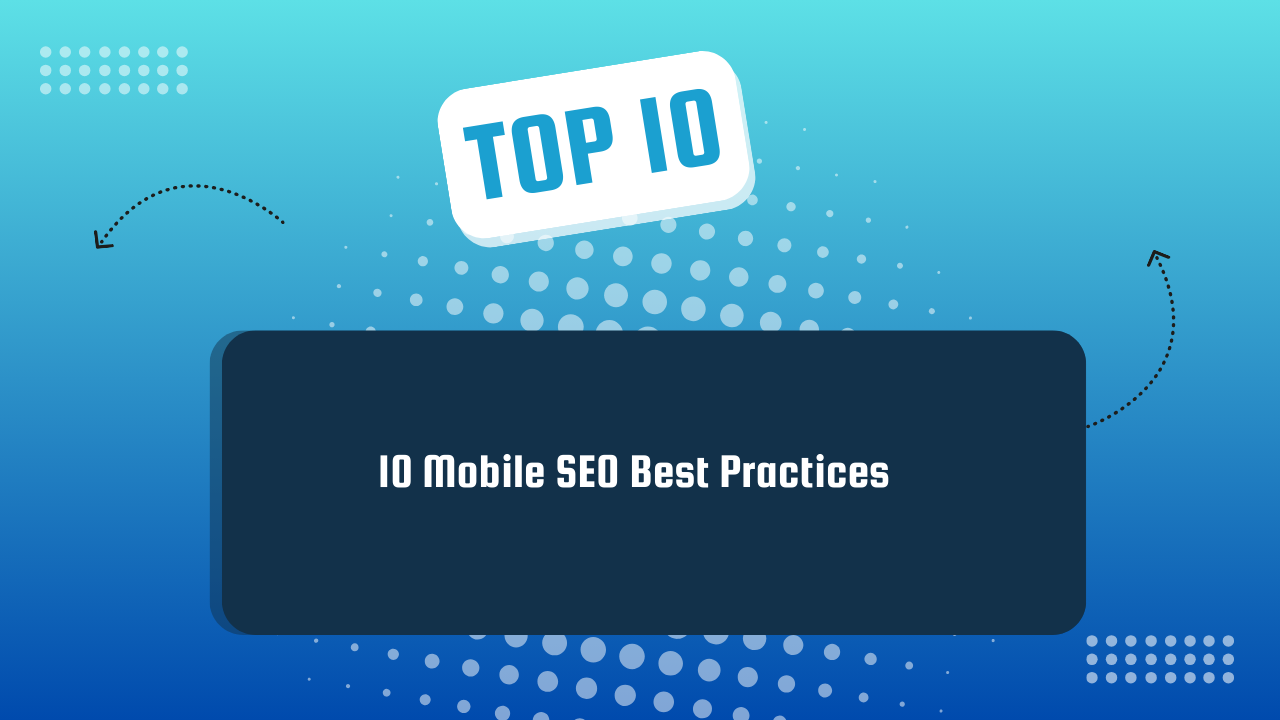Optimizing Your Website for Mobile Search
In today's mobile-first world, having a website that is optimized for mobile devices is crucial for search engine optimization (SEO) success. With the majority of internet users accessing the web through their smartphones and tablets, it's essential to ensure that your website provides a seamless and user-friendly experience on mobile devices. In this comprehensive guide, we'll dive deep into the best practices for mobile SEO to help you improve your website's visibility and rankings in mobile search results.
1. Implement Responsive Web Design
Responsive web design is the foundation of mobile SEO. It ensures that your website adapts and displays properly on different screen sizes and devices. By using responsive design techniques, such as fluid grids, flexible images, and CSS media queries, your website will provide an optimal viewing experience for users, regardless of the device they are using. Responsive design not only improves user experience but also helps search engines understand that your website is mobile-friendly.
When implementing responsive web design, consider the following:
- Use a flexible grid system that adapts to different screen sizes
- Ensure that images and other media elements scale proportionally
- Use CSS media queries to apply different styles based on screen size
- Test your website on various devices to ensure proper rendering and functionality
2. Optimize Page Speed
Page speed is a critical factor in mobile SEO. Mobile users expect websites to load quickly, and slow-loading pages can lead to high bounce rates and lower search rankings. Google has also made it clear that page speed is a ranking factor, emphasizing the importance of optimizing your website's loading time.
To optimize your website's page speed, consider the following:
- Minimize HTTP requests by combining files and using CSS sprites
- Optimize images by compressing them and using appropriate file formats (e.g., JPEG for photographs, PNG for graphics)
- Minify CSS, JavaScript, and HTML files to reduce their size
- Leverage browser caching to store frequently accessed resources locally
- Use a content delivery network (CDN) to distribute your content across multiple servers, reducing latency
- Optimize server response time by choosing a reliable hosting provider and optimizing server configurations
Tools like Google's PageSpeed Insights and GTmetrix can help you assess your website's speed and provide actionable recommendations for improvement.
3. Prioritize Mobile-Friendly Content
When creating content for your website, it's crucial to prioritize mobile users. Mobile screens are smaller, and users often have shorter attention spans when browsing on mobile devices. To optimize your content for mobile:
- Use short, concise paragraphs and headings to make your content easily scannable
- Break up long blocks of text with subheadings, bullet points, and images to improve readability
- Ensure that font sizes are legible on small screens (aim for at least 16px for body text)
- Avoid using Flash or other plugins that may not be supported on mobile devices
- Place important information and call-to-action buttons above the fold to encourage user engagement
- Optimize images and videos for mobile devices, ensuring they load quickly and display properly
By creating mobile-friendly content, you improve the user experience and increase the likelihood of users engaging with your website, which can positively impact your mobile SEO.
4. Optimize for Local SEO
For businesses with a local presence, optimizing for local SEO is crucial. Mobile users often perform local searches to find nearby businesses, products, or services. In fact, according to Google, "near me" searches have increased by 150% in recent years, highlighting the importance of local optimization.
To improve your local SEO:
- Claim and optimize your Google My Business listing, providing accurate and up-to-date information about your business
- Include your business name, address, and phone number (NAP) consistently across your website and online directories
- Encourage customers to leave reviews on popular platforms like Google, Yelp, and Facebook, as positive reviews can boost your local search rankings
- Optimize your website's meta tags and content with local keywords, such as city names and local landmarks
- Create location-specific pages on your website if you have multiple business locations, providing unique and relevant content for each location
- Ensure that your website is mobile-friendly, as local searches are often performed on mobile devices
By optimizing for local SEO, you increase your chances of appearing in local search results and attracting nearby customers, ultimately driving more foot traffic and sales for your business.
READ ALSO:
5. Implement Mobile-Friendly Navigation
Navigation is a crucial aspect of mobile user experience. Mobile users expect easy-to-use and intuitive navigation menus that allow them to quickly find the information they need. A well-designed mobile navigation system can significantly improve user engagement and reduce bounce rates.
Consider the following when implementing mobile-friendly navigation:
- Use a simple and concise navigation menu that focuses on the most important pages and categories
- Implement a responsive hamburger menu for small screens, which expands when tapped to reveal the full navigation
- Ensure that touch targets (buttons and links) are large enough for easy tapping, with sufficient spacing between them
- Use clear and descriptive labels for menu items, avoiding jargon or ambiguous terms
- Provide a search bar for users to quickly find specific content, especially if your website has a large amount of content
- Consider implementing a sticky navigation bar that remains visible as users scroll, providing easy access to navigation options
By implementing mobile-friendly navigation, you improve the usability of your website and encourage users to explore more of your content, ultimately increasing engagement and reducing bounce rates.
6. Leverage Accelerated Mobile Pages (AMP)
Accelerated Mobile Pages (AMP) is an open-source framework developed by Google to create lightweight and fast-loading web pages for mobile devices. AMP pages load almost instantly, providing a smooth and seamless user experience, which can lead to higher engagement and lower bounce rates.
By implementing AMP on your website:
- You can significantly improve your website's loading speed on mobile devices, as AMP pages are designed to be lightweight and optimized for speed
- Your AMP pages may appear in Google's Top Stories carousel, increasing your visibility and potentially driving more traffic to your website
- You can benefit from improved click-through rates and reduced bounce rates, as users are more likely to engage with fast-loading pages
- You can provide a better user experience for mobile users, which can indirectly impact your mobile SEO by improving user engagement signals
While AMP is not a direct ranking factor, it can indirectly impact your mobile SEO by providing a better user experience and potentially increasing user engagement. However, it's important to note that implementing AMP requires technical expertise and may not be necessary for all websites.
7. Monitor and Analyze Mobile Performance
To continuously optimize your website for mobile SEO, it's essential to monitor and analyze your mobile performance regularly. By tracking key metrics and user behavior, you can identify areas for improvement and make data-driven decisions to enhance your mobile SEO strategy.
Use tools like Google Analytics and Google Search Console to:
- Track mobile traffic and user behavior, such as bounce rates, time on site, and conversion rates
- Identify pages with high bounce rates or low engagement, and analyze the reasons behind it
- Monitor your website's mobile search rankings and click-through rates to see how your SEO efforts are impacting your visibility
- Discover and fix mobile usability issues, such as unresponsive pages or touch elements that are too close together
- Set up goals and track conversions to measure the effectiveness of your mobile SEO strategy
In addition to these tools, consider using heatmaps and user session recordings to gain insights into how users interact with your website on mobile devices. This can help you identify user experience issues and optimize your mobile design and content accordingly.
By regularly monitoring and analyzing your mobile performance, you can stay on top of any issues and make informed decisions to improve your mobile SEO. It's important to track your progress over time and continually refine your strategy based on the data and insights you gather.
8. Optimize for Voice Search
With the growing popularity of voice assistants like Google Assistant, Siri, and Alexa, optimizing your website for voice search has become increasingly important. Voice searches tend to be more conversational and longer than typed searches, often in the form of questions.
To optimize your website for voice search:
- Use long-tail keywords and natural language phrases that align with how people speak
- Structure your content in a question-and-answer format, providing concise and direct answers to common questions related to your topic
- Optimize for featured snippets, as voice assistants often read out the featured snippet as the answer to a voice query
- Ensure that your website loads quickly and is mobile-friendly, as many voice searches are performed on mobile devices
- Implement structured data markup (such as Schema.org) to help search engines understand the context and content of your pages
By optimizing for voice search, you can improve your chances of appearing in voice search results and attract users who prefer to use voice assistants for their search queries.
9. Prioritize User Experience
Ultimately, mobile SEO is all about providing a great user experience for mobile users. Google's algorithm prioritizes websites that deliver a seamless and user-friendly experience on mobile devices. By focusing on user experience, you not only improve your mobile SEO but also increase user satisfaction and engagement.
To prioritize user experience:
- Ensure that your website is easy to navigate and has a clear hierarchy of information
- Use a mobile-friendly design that is visually appealing and easy to read on small screens
- Optimize your forms and input fields for mobile devices, making them easy to fill out with minimal typing
- Provide clear and concise calls-to-action (CTAs) that guide users towards desired actions, such as making a purchase or contacting your business
- Ensure that your website is accessible to all users, including those with disabilities, by following web accessibility guidelines
By prioritizing user experience, you not only improve your mobile SEO but also build trust and loyalty with your audience, leading to higher engagement, conversions, and customer satisfaction.
10. Stay Up-to-Date with Mobile SEO Trends and Best Practices
Mobile SEO is an ever-evolving field, with new trends, technologies, and best practices emerging regularly. To stay ahead of the curve and maintain a competitive edge, it's crucial to stay up-to-date with the latest developments in mobile SEO.
Some ways to stay informed include:
- Following industry blogs and publications that cover mobile SEO news and insights
- Attending conferences and webinars focused on mobile SEO and digital marketing
- Participating in online forums and communities where mobile SEO professionals share their knowledge and experiences
- Experimenting with new mobile SEO techniques and technologies, and measuring their impact on your website's performance
- Continuously learning and adapting your mobile SEO strategy based on the latest best practices and algorithm updates
By staying up-to-date with mobile SEO trends and best practices, you can ensure that your website remains competitive and continues to deliver a great user experience for mobile users.
Conclusion
Mobile SEO is no longer an option but a necessity for businesses that want to succeed in today's digital landscape. By implementing responsive web design, optimizing page speed, prioritizing mobile-friendly content, optimizing for local SEO, implementing mobile-friendly navigation, leveraging AMP, monitoring mobile performance, optimizing for voice search, prioritizing user experience, and staying up-to-date with mobile SEO trends, you can improve your website's visibility and rankings in mobile search results.
Remember, mobile SEO is an ongoing process that requires continuous effort and adaptation to keep up with the ever-evolving mobile landscape. By staying committed to mobile SEO best practices and continuously refining your strategy based on data and insights, you can ensure that your website remains competitive and provides an exceptional user experience for mobile users.
Embrace the power of mobile SEO and unlock the potential of reaching and engaging with your audience on their preferred devices. By putting mobile users first and optimizing your website accordingly, you'll be well on your way to achieving mobile SEO success and driving long-term growth for your business.






